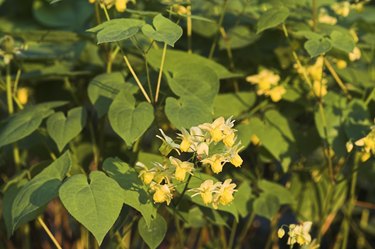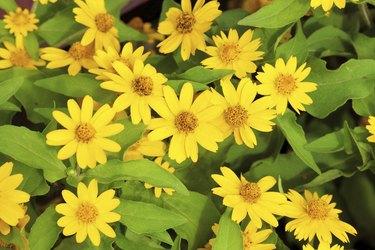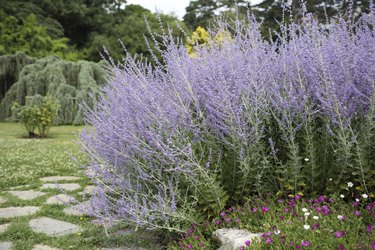
Rabbits aren't so appealing when they eat your prized plants, but growing flowers that figure low on the list of bunny favorites can deter them. Rabbits eat most plants when hungry, but you can live peaceably with them and have a flowering garden by selecting plants that rabbits usually avoid. Removing cover, such as low-hanging branches on shrubs and long grass, also makes your garden less inviting to rabbits.
In the Shade
Video of the Day

Rabbits can lurk unseen in shady spots, but some shade-loving flowers don't taste good to them. Chinese astilbe (Astilbe chinensis var. pumila) grows in partial and full shade and bears plumed clusters of mauve-pink flowers late spring through summer. Growing in mounds of ferny, airy foliage 9 to 12 inches tall and wide, this perennial grows in U.S. Department of Agriculture plant hardiness zones 4 through 8. Bishop's hat "Sulphureum" (Epimedium x versicolor "Sulphureum") is another shade-loving perennial rabbits dislike. Its foliage emerges red in spring, matures to green in summer and turns reddish in fall, and it bears short-spurred, yellow spring flowers. Hardy in USDA zones 5 through 9, bishop's hat "Sulphureum" grows 9 to 12 inches tall and 9 to 18 inches wide.
Video of the Day
Sun-Drenched Patches

Rabbit-tolerant flowers are unappealing to bunnies visiting full-sun sites in the cool of dawn and twilight. Large-flowered tickseed "Early Sunrise" (Coreopsis grandiflora "Early Sunrise"), which grows in USDA zones 4 through 9, bears daisylike yellow flowers up to 2 inches wide late spring through late summer. Remove faded flowers to prolong blooming in "Early Sunrise," which grows 18 to 24 inches tall and wide. Stokes' aster "Klaus Jelitto" (Stokesia laevis "Klaus Jelitto") provides a colorful contrast with its powder blue summer flowers that grow 3 to 4 inches wide. Hardy in USDA zones 5 through 9, "Klaus Jelitto" grows 12 to 18 inches tall and wide.
Dry Zones

In hot, dry summers, drought-tolerant plants that rabbits dislike reduce watering chores without cutting back on flowers. Bigroot geranium "Bevan's Variety" (Geranium macrorrhizum "Bevan's Variety") is named for its thick, spreading rhizomes that quickly form a dense ground cover. Its deep magenta flowers appear in spring and occasionally reappear in summer. "Bevan's Variety" thrives in full sun and partial shade, growing 9 to 12 inches tall and 18 to 24 inches wide, and it grows in USDA zones 3 through 8. Russian sage "Little Spire" (Perovskia atriplicifolia "Little Spire") bears tall branches of violet-blue flowers above clumps of finely dissected, aromatic foliage 18 to 24 inches tall and wide. Hardy in USDA zones 4 through 9, "Little Spire" thrives in full sun.
Rain Garden

When rabbits get their feet wet in your moist garden, grow flowers they usually avoid. Siberian iris "Caesar's Brother" (Iris "Caesar's Brother") grows in USDA zones 3 through 8 and thrives in moist, fertile soil. Producing deep purple spring flowers on spikes 40 inches tall, "Caesar's Brother" grows in clumps of grassy foliage 36 to 48 inches tall and 30 to 36 inches wide. Cardinal flower "Queen Victoria" (Lobelia cardinalis "Queen Victoria") bears vivid red spikes of summer flowers above clumps of dark reddish-purple foliage 36 to 48 inches tall and 18 to 24 inches wide. Hardy in USDA zones 4 through 9, "Queen Victoria" requires constant moisture. Both flowers grow in full sun and partial shade, though "Queen Victoria" only tolerates full sun in cooler zones.
- Missouri Botanical Garden: Astilbe Chinensis Var. Pumila
- Missouri Botanical Garden: Epimedium X Versicolor "Sulphureum"
- Missouri Botanical Garden: Coreopsis Grandiflora "Early Sunrise"
- Missouri Botanical Garden: Stokesia Laevis "Klaus Jelitto"
- Missouri Botanical Garden: Geranium Macrorrhizum "Bevan's Variety"
- Missouri Botanical Garden: Perovskia Atriplicifolia "Little Spire"
- Missouri Botanical Garden: Iris "Caesar's Brother"
- Missouri Botanical Garden: Lobelia Cardinalis "Queen Victoria"
- New Jersey Agricultural Experiment Station: Keeping Rabbits Away From Desirable Plants in Your Garden and Landscape
- Pennsylvania State University Extension: Rabbit-Resistant Garden and Landscape Plants
- Colorado State University Extension: Ravishing Rabbit Revenge